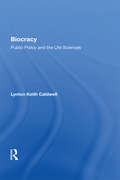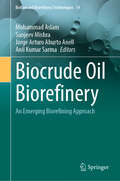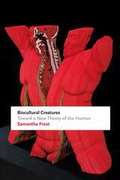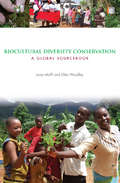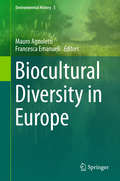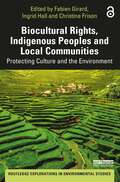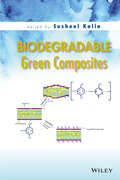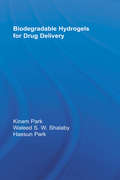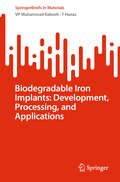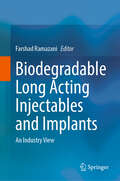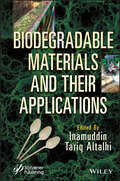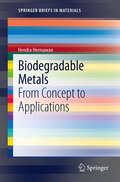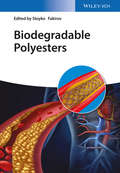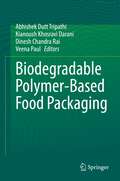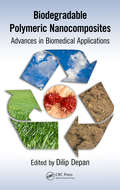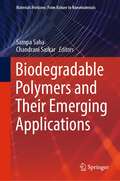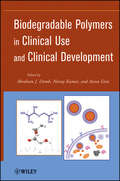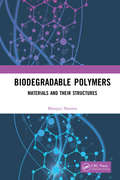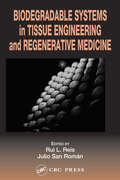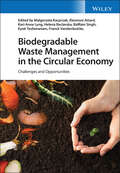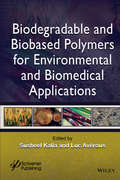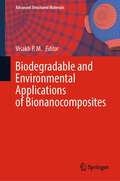- Table View
- List View
Biocracy: Public Policy And The Life Sciences
by Lynton Keith CaldwellBiocracy, a term invented by physiologist Walter Bradford Cannon, refers to the influence of biological science on society and its public policies. Beginning with the prophetic essay “Biopolitics: Science, Ethics, and Public Policy,†this book addresses various aspects of the relationships among the life sciences, society, and government. Included in the topics considered are some of the more critical issues of our time: the social responses to life science innovations; health and homeostasis as social concepts; the relationship between history and biology and that between the life sciences and the law; biocratic interpretations of ethical behavior and biopolitical conflicts; and the options, risks, and international consequences of biotechnology. Caldwell’s book is a collection of articles that he wrote on this subject over a period of twenty-five years. Of the ten chapters, four have previously appeared in scholarly journals but have undergone extensive editorial revisions appropriate to this publication. The remaining six chapters have been presented at various professional meetings but have not hitherto been available in print.
Biocrude Oil Biorefinery: An Emerging Biorefining Approach (Biofuel and Biorefinery Technologies #14)
by Mohammad Aslam Anil Kumar Sarma Sanjeev Mishra Jorge Arturo Aburto AnellBiorefineries are increasingly important in providing sustainable routes to the oil industry. This book provides a comprehensive analysis of biocrude biorefinery to convert biocrude into environmentally friendly fuels and high-value-added products.It begins by discussing the biorefinery concept with its fundamentals and biocrude biorefinery as a sustainable solution for bioenergy and the green economy, explaining the chemistry and reaction mechanism behind biocrude production and analysing the different feedstocks, including lignocellulosic biomass, for biocrude production, recent developments and associated challenges.The second part focuses on waste oils and liquid wastes for sustainable biocrude oil production in a biorefinery approach, as well as on 3rd generation of biorefinery feedstocks (algal biomass) as emerging feedstock for biocrude oil production and high-value products in biorefineries and biocrude oil derived from municipal and industrial organic wastes in the framework of a waste biorefinery concept. Furthermore, bio-oil constitutes a promising energy source for future hydrogen production as well as for the catalytic conversion of crude bio-oil into environmentally friendly transport fuels. The physicochemical and analytical techniques used for the analysis of crude bio-oil with fuel properties and international standards, as well as microbial production and its future applications are also covered.This book will be of great interest to practitioners, graduate students, researchers and policymakers involved in crude bio-oil biorefineries for sustainable development. This book also explores the relationship between biofuels and Sustainable Development Goals (SDGs) 7. Furthermore, the book lays a solid foundation for the establishment of crude bio-oil-based biorefineries and thus contributes to a sustainable, cleaner, greener and livable blue planet for the next generations. Crude bio-oil is likely to be the "green gold" of the biorefinery of the future and this book will be a milestone for biorefineries.
Biocultural Creatures: Toward a New Theory of the Human
by Samantha FrostIn Biocultural Creatures, Samantha Frost brings feminist and political theory together with findings in the life sciences to recuperate the category of the human for politics. Challenging the idea of human exceptionalism as well as other theories of subjectivity that rest on a distinction between biology and culture, Frost proposes that humans are biocultural creatures who quite literally are cultured within the material, social, and symbolic worlds they inhabit. Through discussions about carbon, the functions of cell membranes, the activity of genes and proteins, the work of oxygen, and the passage of time, Frost recasts questions about the nature of matter, identity, and embodiment. In doing so, she elucidates the imbrication of the biological and cultural within the corporeal self. In remapping the relation of humans to their habitats and arriving at the idea that humans are biocultural creatures, Frost provides new theoretical resources for responding to political and environmental crises and for thinking about how to transform the ways we live.
Biocultural Diversity Conservation: A Global Sourcebook
by Luisa Maffi Ellen WoodleyThe field of biocultural diversity is emerging as a dynamic, integrative approach to understanding the links between nature and culture and the interrelationships between humans and the environment at scales from the global to the local. Its multifaceted contributions have ranged from theoretical elaborations, to mappings of the overlapping distributions of biological and cultural diversity, to the development of indicators as tools to measure, assess, and monitor the state and trends of biocultural diversity, to on-the-ground implementation in field projects. This book is a unique compendium and analysis of projects from all around the world that take an integrated biocultural approach to sustaining cultures and biodiversity. The 45 projects reviewed exemplify a new focus in conservation: this is based on the emerging realization that protecting and restoring biodiversity and maintaining and revitalizing cultural diversity and cultural vitality are intimately, indeed inextricably, interrelated. Published with Terralingua and IUCN
Biocultural Diversity in Europe (Environmental History #5)
by Mauro Agnoletti Francesca EmanueliThe book collects a selection of the papers presented at the meeting held in the context of the Joint Programme on the Links between Biological and Cultural Diversity (JP-BiCuD). Recognizing the inextricable link between biological and cultural diversity, the United Nations Educational Scientific and Cultural Organization (UNESCO) and the Secretariat of the Convention on Biological Diversity (SCBD) joined forces, and in 2010 launched the Joint Programme on the Links between Biological and Cultural Diversity (JP-BiCuD). The first meeting for the implementation of the JP-BiCuD was held in Florence (Italy) in April 2014 and produced the UNESCO-sCBD Florence Declaration, which highlights the concept of biocultural diversity. The European rural territory is predominantly a biocultural, multi-functional landscape, providing a crucial and effective space for integration of biological and cultural diversity, suggesting the need to revise some of the current strategies for the assessment and management of biodiversity.
Biocultural Rights, Indigenous Peoples and Local Communities: Protecting Culture and the Environment (Routledge Explorations in Environmental Studies)
by Fabien GirardThis volume presents a comprehensive overview of biocultural rights, examining how we can promote the role of indigenous peoples and local communities as environmental stewards and how we can ensure that their ways of life are protected. With Biocultural Community Protocols (BCPs) or Community Protocols (CPs) being increasingly seen as a powerful way of tackling this immense challenge, this book investigates these new instruments and considers the lessons that can be learnt about the situation of indigenous peoples and local communities. It opens with theoretical insights which provide the reader with foundational concepts such as biocultural diversity, biocultural rights and community rule-making. In Part Two, the book moves on to community protocols within the Access Benefit Sharing (ABS) context, while taking a glimpse into the nature and role of community protocols beyond issues of access to genetic resources and traditional knowledge. A thorough review of specific cases drawn from field-based research around the world is presented in this part. Comprehensive chapters also explore the negotiation process and raise stimulating questions about the role of international brokers and organizations and the way they can use BCPs/CPs as disciplinary tools for national and regional planning or to serve powerful institutional interests. Finally, the third part of the book considers whether BCPs/CPs, notably through their emphasis on "stewardship of nature" and "tradition", can be seen as problematic arrangements that constrain indigenous peoples within the Western imagination, without any hope of them reconstructing their identities according to their own visions, or whether they can be seen as political tools and representational strategies used by indigenous peoples in their struggle for greater rights to their land, territories and resources, and for more political space. This volume will be of great interest to students and scholars of environmental law, indigenous peoples, biodiversity conservation and environmental anthropology. It will also be of great use to professionals and policymakers involved in environmental management and the protection of indigenous rights. The Open Access version of this book, available at www.taylorfrancis.com, has been made available under a Creative Commons Attribution-Non Commercial-No Derivatives 4.0 license
Biocybernetics and Biomedical Engineering – Current Trends and Challenges: Proceedings of the 22nd Polish Conference on Biocybernetics and Biomedical Engineering, Warsaw, Poland, May 19-21, 2021 (Lecture Notes in Networks and Systems #293)
by Janusz Kacprzyk Krzysztof Zieliński Dorota G. Pijanowska Adam LiebertThis book contains 13 chapters in which you can find various examples of the development of methods and/or systems supporting medical diagnostics and therapy, related to biomedical imaging, signal and image processing, biomechanics, biomaterials and artificial organs, modeling of biomedical systems, which, as the current research issues, were presented at the 22nd Polish BBE Conference held at the Nalecz Institute of Biocybernetics and Biomedical Engineering, Polish Academy of Sciences, in May 2021. Obviously, it is not easy to recommend an interdisciplinary book as it may seem inconsistent in some respects. This is the case here because it concerns the area of biocybernetics and biomedical engineering (BBE), which is not only an interdisciplinary but even multidisciplinary science. On the other hand, the scattered subject matter of the book is its advantage, as the book may be of interest to an advanced and wide range of readers and researchers representing both medical, biological and technical points of view.
Biodefense Research Methodology and Animal Models
by James R. SwearengenSignificant advances have been made in animal model development for biological research since the publication of the first edition of this volume, and the ramifications of the FDA's Animal Efficacy Rule have become better understood in the scientific community. With each chapter completely updated with the latest research findings, Biodefense Resea
Biodegradable Green Composites
by Susheel KaliaThis book comprehensively addresses surface modification of natural fibers to make them more effective, cost-efficient, and environmentally friendly. Topics include the elucidation of important aspects surrounding chemical and green approaches for the surface modification of natural fibers, the use of recycled waste, properties of biodegradable polyesters, methods such as electrospinning, and applications of hybrid composite materials.
Biodegradable Hydrogels for Drug Delivery
by Kinam Park Haesun Park Waleed S.W. ShalabyProviding easy access to the subject both for those who are just starting to work in the field and for experienced professionals, this book presents a broad survey of hydrogel synthesis, degradation, and use for drug delivery. Bringing information relevant to biodegradable hydrogels into one resource, the book covers the mechanisms of biodegradation, types of biodegradable hydrogels, chemical and physical gels, chemical and enzymatic degradation, and examples of biodegradable drug delivery systems. An authoritative reference, it gives readers a comprehensive, systematic, science-based reference that covers all aspects of biodegradable hydrogels.
Biodegradable Iron Implants: Development, Processing, and Applications (SpringerBriefs in Materials)
by VP Muhammad Rabeeh T HanasThis book offers a comprehensive guide to iron-based biodegradable metals (BMs) for temporary implant applications, addressing the need for medical implants that can safely degrade within the human body, thereby eliminating the necessity for additional surgeries and reducing long-term complications. Beginning with an introductory overview of BMs, it explains their significance in modern medicine and outlines the essential requirements for these materials and a comparative analysis of magnesium, zinc, and iron-based alloys. This chapter lays the foundation for understanding BMs' role in advancing healthcare solutions. The second chapter focuses on the interaction between iron and the human body, detailing iron's degradation and mechanical characteristics in the physiological environment. It explains the potential degradation routes of iron both in vitro and in vivo, while discussing the advantages and limitations of iron as a BM for temporary implants, supported by references to relevant literature. The third Chapter looks at recent advancements in manufacturing techniques aimed at improving the effectiveness and safety of iron-based implants. It emphasizes material fabrication and explores various manufacturing routes, including powder metallurgy, casting, and additive manufacturing. The performance of components made through different methods in the physiological environment is also examined. In Chapter four, the book covers various metallurgical and surface modification techniques such as alloying, surface treatments, and composite fabrication. It highlights the importance of post-processing developed materials to enhance the properties of iron implants, ensuring controlled degradation and maintaining mechanical strength during the healing process. This chapter provides valuable insights into how to process and customize the characteristics of iron to meet specific medical needs, particularly in cardiovascular and orthopedic medicine. The fifth chapter explores the potential applications of iron-based BMs in various medical fields. It discusses possible uses in cardiovascular, orthopedic, and other medical applications, based on reported literature. The final chapter provide a Summary & Future Prospective of Fe based degradable implants. Overall, this book is targeted at individuals in the fields of biomedical engineering, materials science, and medical practice who are engaged in the development and utilization of medical implants. It aims to significantly advance ongoing efforts by shedding light on novel materials and manufacturing techniques in medical technology.
Biodegradable Long Acting Injectables and Implants: An Industry View
by Farshad RamazaniLong acting injectables and implants (LAI) are known to improve patient adherence and treatment outcomes. They reduce costs for the healthcare system and ensure sustainable sales for pharmaceutical companies. LAI are usually administered intramuscularly (IM) or subcutaneously (SC). In this way, the drug is released from its depot in a controlled manner over a longer period of time (e.g., a few days to a year). There is a trend toward increasing interest in the development of long-acting drugs for local administration versus systemic administration of depot products (i.e., IM or SC injection). This is leading to finding new ways of administration of the depot formulation, intra-ocular, intra-articular, pri-tendon etc. Therefore, it is expected that more drugs based on LAI formulations will enter the clinical phase in the future. Due to many benefits in adherence, efficacy, and safety of the treatment up until now around 50 brand name medicines using different biodegradable long-acting technology have received FDA approval. Manufacturing of LAI involves many steps with their unique challenges, which is why pharmaceutical companies consider them to be complex formulations to develop. Most of the published papers and books in this field are written by scientists who never worked in industry and whose knowledge on the topic is limited to small scale formulation screening. Therefore, this book aims to address the challenges of the development of biodegradable LAI from an industrial perspective.
Biodegradable Materials and Their Applications
by Inamuddin Tariq A. AltalhiBIODEGRADABLE MATERIALS AND THEIR APPLICATIONS Biodegradable materials have ascended in importance in recent years and this book comprehensively discusses all facets and applications in 29 chapters making it a one-stop shop. Biodegradable materials have today become more compulsory because of increased environmental concerns and the growing demand for polymeric and plastic materials. Despite our sincere efforts to recycle used plastic materials, they ultimately tend to enter the oceans, which has led to grave pollution. It is necessary, therefore, to ensure that these wastes do not produce any hazards in the future. This has made an urgency to replace the synthetic material with green material in almost all possible areas of application. Biodegradable Materials and Their Applications covers a wide range of subjects and approaches, starting with an introduction to biodegradable material applications. Chapters focus on the development of various types of biodegradable materials with their applications in electronics, medicine, packaging, thermoelectric generations, protective equipment, films/coatings, 3D printing, disposable bioplastics, agriculture, and other commercial sectors. In biomedical applications, their use in the advancement of therapeutic devices like temporary implants, tissue engineering, and drug delivery vehicles are summarized. Audience Materials scientists, environmental and sustainability engineers, and any other researchers and graduate students associated with biodegradable materials.
Biodegradable Metals: From Concept to Applications (SpringerBriefs in Materials)
by Hendra HermawanThis book in the emerging research field of biomaterials covers biodegradable metals for biomedical applications. The book contains two main parts where each of them consists of three chapters. The first part introduces the readers to the field of metallic biomaterials, exposes the state of the art of biodegradable metals, and reveals its application for cardiovascular implants. Some fundamental aspects to give basic understanding on metals for further review on the degradable ones is covered in chapter one. The second chapter introduces the concept of biodegradable metals, it's state of the art and discuses a shifted paradigm from inert to bioactive, from corrosion resistant to corrodible metals. The third chapter focuses on the challenges and opportunities of using biodegradable metals for cardiovascular applications. The second part exposes an example of biodegradable metals from its concept to applications where a complete study on metallic biodegradable stent is detailed from materials design, development, testing till the implant fabrication. The forth chapter reveals new alloys development devoted for metallic biodegradable stent based on required criteria derrived from clinical needs and current nondegradable stents properties. Degradation of the alloys in simulated arterial conditions and its effect to cells are exposed in chapter five. The both chapters are concluded with a benchmarking of some more recent researches on materials development and testing for biodegradable stents. Chapter six reveals the tranformation process of the materials into stent prototypes where a standard process for making 316L stainless steel stents was followed. The book is completed by a perspective on the use of biodegradable metals for biomedical applications in the era of tissue engineering.
Biodegradable Polyesters
by Stoyko FakirovCollating otherwise hard-to-get and recently acquired knowledge in one work, this is a comprehensive reference on the synthesis, properties, characterization, and applications of this eco-friendly class of plastics. A group of internationally renowned researchers offer their first-hand experience and knowledge, dealing exclusively with those biodegradable polyesters that have become increasingly important over the past two decades due to environmental concerns on the one hand and newly-devised applications in the biomedical field on the other. The result is an unparalleled overview for the industrial chemist and materials scientist, as well as for developers and researchers in industry and academia alike.
Biodegradable Polymer-Based Food Packaging
by Abhishek Dutt Tripathi Kianoush Khosravi Darani Dinesh Chandra Rai Veena PaulThis book covers different aspects of biodegradable packaging, such as their sourcing and application in food industries. The book focuses on the production and characterization of biodegradable food packaging derived from plant, animal and microbial sources. Chapters highlight the nano-technological interventions in biodegradable food packaging and the less studied microbial biopolymer-based biodegradable food packaging makes it distinct from other related books. It includes the latest research and development in the areas of food processing, food packaging, material science and polymeric science. It also discusses the standards and regulatory guidelines about the biodegradability testing of these polymers.This book is meant for researchers in food science, food packaging, bioprocess technology, polymer science and biochemical engineering. It is also beneficial for faculty members and students of food microbiology, food technology, dairy technology. The book is also meant for small entrepreneurs and farmers who are interested in bio-plastic usage for food packaging.
Biodegradable Polymeric Nanocomposites: Advances in Biomedical Applications
by Dilip DepanHow Can Polymers Constructed From Living Organisms Help Eliminate the Disposal Issue? A unique category of materials called biodegradable polymers could help remedy a growing environmental concern. Biodegradable Polymeric Nanocomposites: Advances in Biomedical Applications considers the potential of biodegradable polymers for use in biomedical appl
Biodegradable Polymers and Their Emerging Applications (Materials Horizons: From Nature to Nanomaterials)
by Sampa Saha Chandrani SarkarBio-degradable polymers are rapidly emerging as a sustainable alternative to traditional petroleum-based plastics and polymers. However, the synthesis and processing of such polymers present unique challenges and opportunities. In this comprehensive volume, Dr. Saha and her team provide an in-depth exploration of the synthesis and processing of bio-degradable polymers and their emerging applications in various sectors from drug delivery to food packaging. Covering a wide range of topics, including synthesis, modification, processing techniques, and few of their advanced applications in emerging areas, this book provides a comprehensive overview of the field. The authors also delve into cutting-edge research on the synthesis, properties and applications of bio-degradable polymers in various fields, such as agricultural, food preservation, biomedical arena, energy storage and other advanced application areas. This volume is an essential resource for scientists, engineers, and policymakers interested in the future of sustainable materials. Whether you are a researcher looking to expand your knowledge of biodegradable polymer synthesis and processing or a policymaker interested in the potential of biodegradable polymers to reduce our reliance on fossil fuels, this book is an invaluable guide to the field.
Biodegradable Polymers in Clinical Use and Clinical Development
by Abraham J. Domb Neeraj Kumar Aviva EzraThis book focuses on biodegradable polymers that are already in clinical use or under clinical development. Synthetic and natural polymers will be included. This excludes polymers that have been investigated and did not reach clinical development. The purpose of this book is to provide updated status of the polymers that are clinical use and those that are now being developed for clinical use and hopefully will reach the clinic during the next 5 years. The book provides information that of interest to academics and practicing researchers including chemists, biologists and bioengineers and users: physicians, pharmacists.
Biodegradable Polymers in the Circular Plastics Economy
by Michiel Dusselier Jean-Paul LangeBiodegradable Polymers in the Circular Plastics Economy A comprehensive overview of the burgeoning field of biodegradable plastics As the lasting impact of humanity’s reliance on plastics comes into focus, scholars have begun to seek out solutions to plastic litter. In Biodegradable Polymers in the Circular Plastics Economy, an accomplished team of researchers delivers a focused guide (1) to understand plastic degradation and its role in waste hierarchy besides recycling, and (2) to create and use biodegradable plastics where appropriate. Created preferably from renewable resources, these eco-friendly polymers provide an opportunity to create sustainable and lasting solutions to the growing plastic-driven pollution problem. The broad approach to this handbook allows the authors to cover all aspects of these emerging materials, ranging from the problems present in the current plastics cycle, to the differences in type, production, and chemistry available within these systems, to end-of-life via recycling or degradation, and to life-cycle assessments. It also delves into potential commercial and policy issues to be addressed to successfully deploy this technology. Readers will also find: A thorough introduction to biodegradable polymers, focusing not only on the scientific aspects, but also addressing the larger political, commercial, and consumer concerns Mechanisms of biodegradation and the environmental impact of persistent polymers An in-depth discussion of degradable/hydrolysable polyesters, polysaccharides, lignin-based polymers, and vitrimers Management of plastic waste and life cycle assessment of bio-based plastics Biodegradable Polymers in the Circular Plastics Economy is the perfect overview of this complicated but essential research field and will appeal to polymer chemists, environmental chemists, chemical engineers, and bioengineers in academia and industry. The book is intended as a step towards a circular plastics economy that relies heavily on degradable plastics to sustain it.
Biodegradable Polymers: Materials and their Structures
by Manjari SharmaThis book is about development of biodegradable polymers alternatives, which are required to save our reserves of fossil fuels and to save our mother earth from further environmental degradation. This book deals with the family of biodegradable polymers which have to be prepared with a novel idea of studying polymers with a “Cradle to Grave” approach. It touches upon basic materials, which can be potential materials to prepare biodegradable polymers with their basic structures, properties, behaviour and limitations known till date. This book will help students in understanding various characterization techniques which can be used for the study of identification of functional group, structural properties, thermal behaviour, crystallographic nature, mechanical properties and morphological properties through FTIR–ATR for physico chemical properties, DSC & TGA for thermal studies, XRD for crystallographic studies & SEM for morphological studies. It also provides an overview of various testing methods to analysebiodegradability including standard guideline for evaluation of biodegradation and compostability of polymer material through ASTM/ISO/EN standard methods. Note: T&F does not sell or distribute the Hardback in India, Pakistan, Nepal, Bhutan, Bangladesh and Sri Lanka.
Biodegradable Systems in Tissue Engineering and Regenerative Medicine
by Rui L. Reis Julio San RománConventional materials technology has yielded clear improvements in regenerative medicine. Ideally, however, a replacement material should mimic the living tissue mechanically, chemically, biologically and functionally. The use of tissue-engineered products based on novel biodegradable polymeric systems will lead to dramatic improvements in health
Biodegradable Waste Management in the Circular Economy: Challenges and Opportunities
by Malgorzata KacprzakBiodegradable Waste Management in the Circular Economy Presents the major developments in new technologies and strategies for more effective recovery of matter, resources, and energy from biodegradable waste The volume of biodegradable waste produced worldwide is progressively increasing—a trend that is predicted to continue well into the foreseeable future. Developing sustainable, cost-effective, and eco-friendly approaches for processing food waste, agricultural and organic industrial waste, cardboard, biodegradable plastics, sewage sludge, and other types of biodegradable waste is one of the most significant challenges of the coming decades. Biodegradable Waste Management in the Circular Economy provides a detailed overview of the latest advances in the management of biomass for economic development. Featuring contributions from an interdisciplinary team of experts, this comprehensive resource addresses various technologies and strategies for recycling organic matter and many other renewable compounds. In-depth chapters describe the concept of circular economy, identify new sources of biodegradable waste, explore technologies for the production of biodegradable waste end-products, discuss the positive and negative effects of end-products on soil and the environment, and more. Throughout the text, the authors explore systematic approaches for secure biodegradable management in various countries and regions around the world. Explores the social, governance, and economic aspects of “waste as a resource” Addresses metal recovery, biofuel and fertilizer production, and biosorbents and biochar derived from biomass waste Discusses nutrient recovery and energy and bio-methane production from biodegradable waste Covers use cases, collection systems, and regulation of agricultural, industrial, and municipal biodegradable waste streams Presents various technologies for the production of biodegradable waste end-products, including biorefineries, anaerobic digestion, and hybrid methods Reflecting the latest trends in the rapidly changing field, Biodegradable Waste Management in the Circular Economy is essential reading for researchers, engineers, scientists, and consultants working in waste engineering and management, resource recovery, renewable resources, environmental science, agricultural and environmental engineering, soil science, and bioenergy.
Biodegradable and Biobased Polymers for Environmental and Biomedical Applications
by Luc Avérous Susheel KaliaThis volume incorporates 13 contributions from renowned experts from the relevant research fields that are related biodegradable and biobased polymers and their environmental and biomedical applications. Specifically, the book highlights: Developments in polyhydroxyalkanoates applications in agriculture, biodegradable packaging material and biomedical field like drug delivery systems, implants, tissue engineering and scaffolds The synthesis and elaboration of cellulose microfibrils from sisal fibres for high performance engineering applications in various sectors such as the automotive and aerospace industries, or for building and construction The different classes and chemical modifications of tannins Electro-activity and applications of Jatropha latex and seed The synthesis, properties and applications of poly(lactic acid) The synthesis, processing and properties of poly(butylene succinate), its copolymers, composites and nanocomposites The different routes for preparation polymers from vegetable oil and the effects of reinforcement and nano-reinforcement on the physical properties of such biobased polymers The different types of modified drug delivery systems together with the concept of the drug delivery matrix for controlled release of drugs and for antitumor drugs The use of nanocellulose as sustainable adsorbents for the removal of water pollutants mainly heavy metal ions, organic molecules, dyes, oil and CO2 The main extraction techniques, structure, properties and different chemical modifications of lignins Proteins and nucleic acids based biopolymers The role of tamarind seed polysaccharide-based multiple-unit systems in sustained drug release
Biodegradable and Environmental Applications of Bionanocomposites (Advanced Structured Materials #177)
by Visakh P. M.This book provides cutting-edge, up-to-date research findings on the use of bionanocomposites in biodegradable and environmental applications, while also detailing how to achieve bionanocomposites preparation, characteristics, and significant enhancements in physical, chemical, mechanical, thermal properties and applications. This book on biodegradable and environmental properties of bionanocomposites provides a comprehensive and updated review of major innovations in the field of polymer-based bionanocomposites for biodegradable and environmental applications. It covers properties and applications, including the synthesis of polymer-based bionanocomposites from different sources biomaterials-based composites and tactics on the efficacy and major challenges associated with successful scale-up fabrication on bionanocomposites.It is an essential reference for future research in bionanocomposites as topics such as sustainable, biodegradable, and environmental methods for highly innovative and applied materials are current topics of importance. The book covers a wide range of research on bionanocomposite and their biodegradable and environmental applications. Updates on the most relevant polymer-based bionanocomposite and their prodigious potential in the fields of biodegradable and the environment are presented. Leading researchers from industry, academy, government, and private research institutions across the globe contribute to this book. Scientists, engineers, and students with interest in the most important advancements in the field of bionanocomposites involving high-performance bionanocomposites will benefit from this book which is highly application-oriented.
